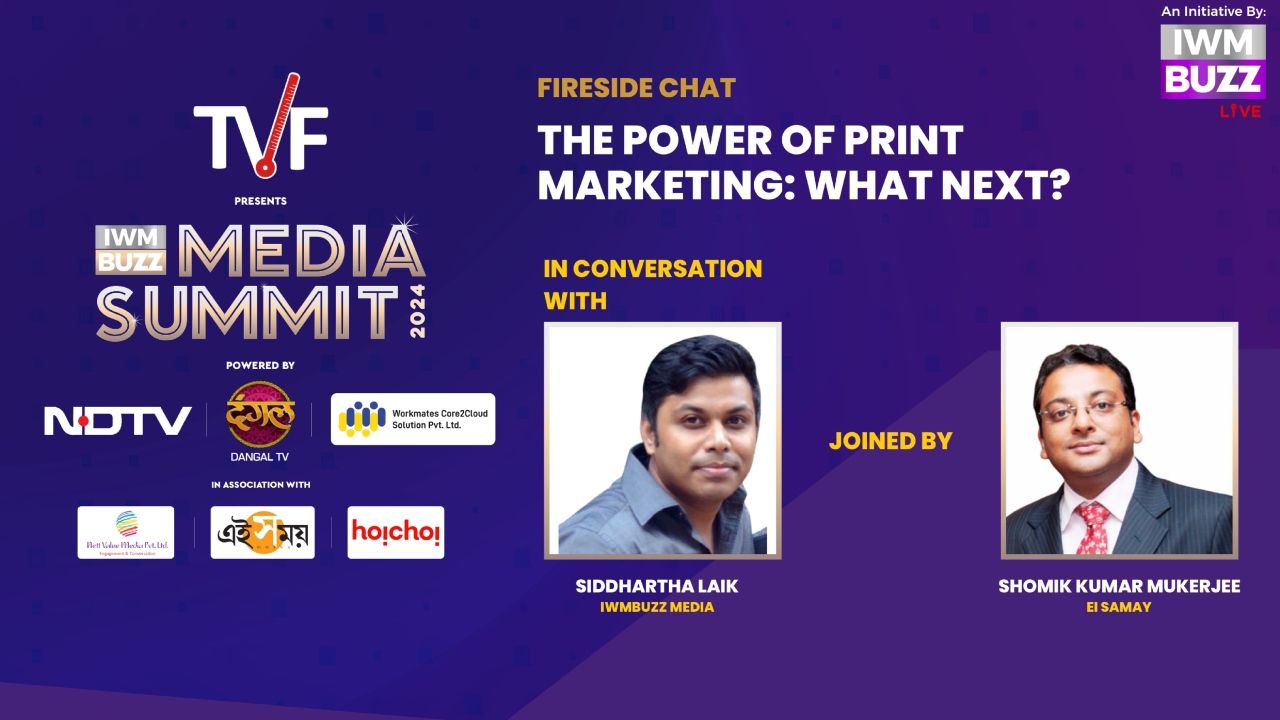The November 14 Media Summit, spearheaded by IWMBuzz held a torch for the industrious aspirants in Kolkata. Diving into broad-gauged discussions spiralling from the spheres of advertising, marketing, cinema, and more, the Media Summit sprouted as a one-of-a-kind visionary start in the city of joy.
And as we speak of visionary, Siddhartha Laik, editor-in-chief of IWMBuzz curated a revolutionary ‘fireside chat’ with the Executive Director & CCO of Ei Samay, Shomik Kumar Mukherjee, at the media summit. Enveloping on the grounds of ‘print marketing’ and its ‘power,’ the conversation definitely called for a rebellious stand in the era of digital.
There is no denying that the ‘take over’ of the digital is evident. However, the relevance of ‘print’ should constantly be in the realm of journalism to cocoon its legacy.
That is where ‘Ei Samay’ makes a difference, sprouting as a rebel against time.
Here are some excerpts from the conversation:
Siddhartha Laik: In the times when television is in question, you know where we are talking about AI and consumer engagement. People say print advertisements are going down post-COVID; standing there, do you think print matters?
Shomik Kumar Mukherjee: There are two ways to look at it. Print doesn’t matter globally. The global ad spend of print is 4%. The global ad spend of the US and UK is 5%.
In media, one has to have their data and the source of data right. According to the Ernst & Young report, India is currently spending 20% on print. There must be a reason behind this happening. The other side is that the industry has seen the worst during COVID. The advertising market went through a slump.
But post-COVID, the situation has turned. In 2023-2024, we are expecting a 4% growth. More interesting is that pre-COVID ad spending has returned to 76% for English newspapers. When discussing with Dr Batra, it was evident that the linguistics and vernaculars are working, and current pre-COVID levels are back to 96% for vernaculars.
That is the power of print, which is geo-targeted to the person you want to speak to through the advertiser who wants to talk to that person. So, there is absolutely no reason to think that print will disappear anywhere.
Siddhartha Laik: Absolute optimism that I can sense from you. But you’re always in a competitive space. I don’t want to name other newspapers in the market, but there are established names. So, what’s your strategy to stay ahead in this competitive norm?
Shomik Kumar Mukherjee: 244 years ago, a gentleman who was known to be eccentric, an Irish man by the name of James Augustus Hicky, started a newspaper in Kolkata with only 400 readers, once a week on Saturdays. It was called The Bengal Gazette. It was 1 rupee for each newspaper. 244 years later, I say this with great pride: Ei Samay is the highest-cost cover price over regional giants. I charge a rupee more per day because the readers support my content.
But after 244 years, we have reached 6 rupees per newspaper. So, in 244 years, the price has not increased, but the value has not depreciated.
We will not find a product like this. The newspaper started in 54 BC, in Roman Times. There were handwritten notes of paper put up in important town halls to announce only four things. Important events for the week, birth, death and gossip.
Starting in Bengal, print keeps being relevant here. Bengalis are habitual readers. Bengal has the highest percentage of habitual readers.
Siddhartha Laik: Today, a huge number of audiences might not pick up a newspaper. To create awareness, how are you integrating the core ‘print’ ideology to reach a larger audience?
Shomik Kumar Mukherjee: Digital today and with AI come with fake news, comes interpretation of news, news with colours, news with paid content, and news with an agenda.
Why do you need print? My editors are not storywriters. Twenty years later, if you want to know what happened today, and if this is covered in print, you’ll find it in the archives of various libraries. And this, every day’s newspaper is a contribution of every single person to the history of what is happening to the land.
Digital will be there. We have a full-fledged digital side. We will have influencers. We will be having podcasts, and we will be breaking stories.
The discussion at the Media Summit highlighted something crucial—the undeniable resilience of print media, even in a world dominated by digital platforms. While digital thrives on speed and scale, print offers something deeper: trust, permanence, and a tangible connection to history.
Ei Samay’s journey is proof that innovation and tradition can coexist.
Title Partner: TVF
Powered by: NDTV | Dangal TV | Workmates Core2Cloud Solution Pvt. Ltd.
In Association with: Nett Value Media Pvt. Ltd. | Ei Samay | Hoichoi
Partners: Taarak Mehta Ka Ooltah Chashmah Rhymes | Redington Limited | White Frames | Just Lateral ThinkInk | Celebistaan | Decalogue
Watch the full video below:

